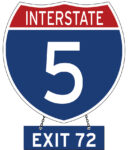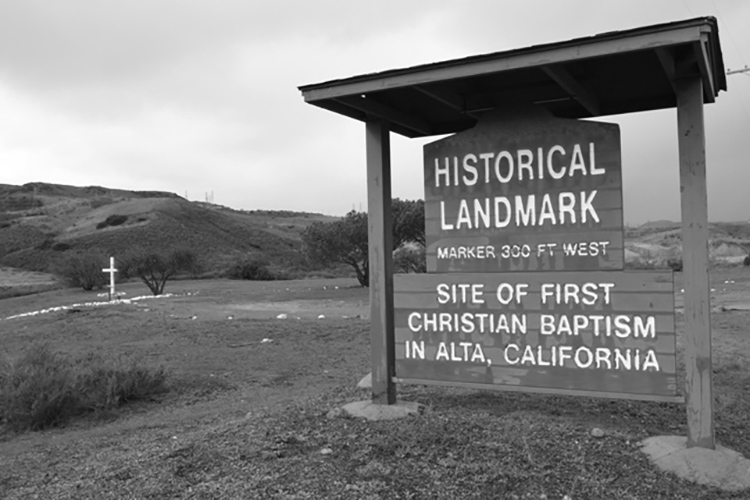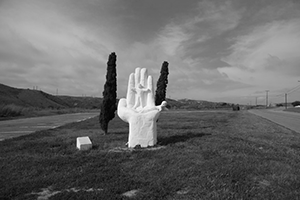 Editor’s Note: This is the 30th and final chapter in Volume 3 of Publisher and Editor Donald H. Harrison’s 2022 trilogy, “Schlepping and Schmoozing Along the Interstate 5.” All three books as well as others written by Harrison may be purchased from Amazon.com
Editor’s Note: This is the 30th and final chapter in Volume 3 of Publisher and Editor Donald H. Harrison’s 2022 trilogy, “Schlepping and Schmoozing Along the Interstate 5.” All three books as well as others written by Harrison may be purchased from Amazon.com
Schlepping and Schmoozing Along the Interstate 5, Volume 3, Exit 72 (Cristianitos Road): Site of First Christian Baptism in California

 CAMP PENDLETON, California – Northbound Interstate 5’s last exit in San Diego County is Cristianitos Road, Spanish for ‘the Little Christians.” How did it get such a name, and what might Jewish history have to do with such a place?
CAMP PENDLETON, California – Northbound Interstate 5’s last exit in San Diego County is Cristianitos Road, Spanish for ‘the Little Christians.” How did it get such a name, and what might Jewish history have to do with such a place?
In 1769, Gaspar de Portolá, the soldier and acting governor of Las Californias, led a 63- person expedition up the coast from San Diego to solidify Spain’s claim over California against a rival claim by the British. Two Franciscan Padres accompanied him. One was Father Francisco Gómez and the other was Father Juan Crespi, who kept a diary detailing the expedition.
Along the way, at a place that today hugs the border between San Diego County and Orange County, the expedition paused for an overnight stay. Members of the indigenous Ajachemen “Ah-HAWSH-eh-men people, in alarm, signified to scouts for the expedition that two girls were gravely ill. Unable to restore the girls to health, Father Gómez baptized one as Maria Magdalena on July 22, 1769. In Catholic belief, he thereby enabled her to go to heaven. Father Crespi baptized the other dying girl, naming her Margarita. A plaque on Camp Pendleton’s grounds notes that the first baptism occurred “near this spring.”
In his diary, Crespi recorded, “Saturday, July 22. At about 7 o’clock we continued over course toward the West. At about 11 o’clock, having traveled four leagues, more or less, we arrived at a pool of water. Near this pool we camped. Our scouts informed us that yesterday they had found two sick baby girls in a rancheria. We therefore asked the commandant for an escort of soldiers, and then visited them. We found one of the children to all appearances dying on its mother’s breast. We begged her for permission to examine the child; but, although we tried to make the little girl understand that it was not our intention to harm her – that we desired only to wash her head in order that, if she should die, she might go to Heaven, the child refused to loosen her hold on her mother. At last, we induced the mother to let us carry out our desire. Thereupon, my companion, Father Francisco Gómez, baptized the little girl, giving her the name of Maria Magdalena. Later on, we visited the other sick girl, who was badly burnt and seemingly also at death’s door. We baptized her under the name of Margarita. On account of this incident the soldiers called the place Los Cristianitos. I named it for San Apolinario and to others it is known as La Cañada de los Bautismos (Canyon of the Baptisms).
It has been assumed that the two little girls died shortly after the expedition on, but their exact fate – and even their Ajachemen names – is lost to history.
The place where the first baptism occurred subsequently became known as “La Cristianita,” meaning “the little Christian.” The exit from the freeway is “Cristianitos Road,” for “the little Christians.”
It is generally accepted that the Christian rite of baptism is derived from the Jewish practice of immersing in a mikveh at critical moments in one’s life.
The Jewish preacher whom Christians revere as “John the Baptist” used to encourage people to immerse themselves in or near the Jordan River as an act of teshuvah, or repentance. The symbolism of the rite is to be born again, coming out of a womb of water, washed of one’s sins, and ready to begin a new chapter of one’s life. Thus, when non-Jews convert to Judaism, one of the required rites is immersing in a pool of water known as a mikveh.
John the Baptist officiated over the baptism of Jesus at Bethany, beyond the Jordan. In Christian belief, Jesus was perfect, absolutely without sin, so why would he need to repent? The answer was that immersing in the mikveh also could mark the approach to a new phase in one’s life—before marriage, for example. For Christians, the immersion of Jesus at Bethany marked the official beginning of his momentous rabbinate.
The methods of mikveh and baptism differed. Whereas our fellow Jews will immerse in the mikveh unaccompanied, Christian officiants often assist the person being baptized, in essence dunking him or her under the water.
There are doctrinal differences among Christians about what are appropriate times and methods for baptism.
Some Christians believe any living person may be baptized, regardless of age. Other Christians say that baptisms should not be conducted until the person is old enough to understand the meaning of his or her commitment to a Christian way of life.
Another difference found some Christians insisting that a proper baptism required being fully immersed under water, as Jews were in the mikveh, while others like the Padres Gómez and Crespi believed pouring or sprinkling water on the subject’s head sufficed.

In 1975, the area of Camp Pendleton close to La Cristianita was utilized as a relocation camp for approximately 50,000 Vietnamese and Cambodian refugees who were airlifted to California following American withdrawal from Southeast Asia.
While there were no pools of water in which to ritually immerse themselves, for many of the refugees their stay in the camp’s tents and Quonset huts was a kind of baptism into their new lives as Americans.
There is a monument on the Camp Pendleton grounds marking the supposed site of the first baptism. However, it has been generally inaccessible to civilians since the September 11, 2001, terrorist attacks on the United States. Soon after those attacks, military installations were closed to casual visitors, and they have remained so.
The government of neighboring Orange County subsequently cooperated with the California State Parks Commission in erecting a replacement marker at the Casa Romantica Cultural Center and Gardens in San Clemente. It reads: La Cristianita –Two miles inland from this point, in Los Cristianitos Valley, the first Christian Baptism in Alta [Upper] California was performed by Padre Francisco Gómez, a member of the Portola expedition in 1769.” It is California’s Registered Historical Landmark No. 562. Next to the plaque is an image of an Indian woman kneeling in reverence while holding her child up to a Franciscan padre, clearly a romanticized version of the event.
In the past, civic groups in San Clemente annually produced The Cross and the Arrow Pageant of La Cristianita. Following the placement of the new monument at La Casa Romantica, there was speculation that the pageant might be revived.
Over the years, the federal court system has adjudicated controversies arising from the wording of the First Amendment to the U.S. Constitution. It reads: “Congress shall make no law respecting an establishment of religion, or prohibiting the free exercise thereof; or abridging the freedom of speech, or of the press, or the right of the people to peaceably assemble, and to petition the Government for a redress of grievances.”
Generally, it has been held that religious symbols may not be permanently placed on government property but may be placed there on a temporary basis in furtherance of the freedoms of assembly and speech. Every December in San Diego, the Spreckels Organ Pavilion at Balboa Park is the scene of creches depicting events surrounding the birth of Jesus. Courts ruled that because the creches were temporary, they did not amount to an establishment of Christianity as the City of San Diego’s official religion.
In La Jolla, a large Latin Cross was erected at Mount Soledad, which at the time was government property. On several occasions, courts ruled that the cross must be relocated to private property. Following appeals, a compromise was reached when the land surrounding the cross was sold to a private nonprofit group that had made the cross the centerpiece of a memorial to U.S. military veterans. Individual plaques at the site honor people of various religions, including Jews.
The geographic names “San Diego,” “La Cristianita,” and “San Clemente” all are derived from Christianity. The masculine “San” and the feminine “Santa” mean “Saint” in Spanish. While many Christians believe in saints, Jews typically do not. One might argue those geographic names enshrine Christianity, but the prevailing counter-argument is that they reflect historic events. When Spanish explorers claimed land for their mother country, they referred to a calendar listing the dates of the feast days for the various Catholic saints. The places were named for the saint whose feast day occurred on the day of that discovery or was closest to that day.
Although it didn’t come into use, Father Crespi chose the name “San Apolinario” because the date the expedition camped at the pool of water was July 22nd. The Roman Catholic Church had assigned July 23rd as the feast day of Saint Apollinaris of Ravenna, as San Apolinario was known in English. According to the church’s martyrology, he was murdered in the early days of Christianity by Romans who rejected his preaching.
The names of California localities are windows into the state’s early history, which I believe is important to learn. While the name “San Diego” frequently appears in my writings, or in my speech, some of my fellow Jews believe that in naming saints, we acquiesce to Christian’s God. Following that logic, Chabad rabbis rigorously avoid mentioning saints’ names. In official literature from that Chasidic organization, “San Diego” is rendered as “S. Diego.”
As I conclude this book, I’d like to express a view that differs from some of my co-religionists. I take pride in seeing places that acknowledge Jewish history and Jewish contributions to the American story. I imagine Christians as well as people of other religions take similar pride in seeing the accomplishments of their co-religionists likewise acknowledged. I believe we should celebrate each other’s achievements, not just our own, and thereby underscore the delightful fact that America is a place built upon religious and ethnic diversity.
*
Donald H. Harrison is publisher and editor of San Diego Jewish World. He may be contacted via sdheritage@cox.net